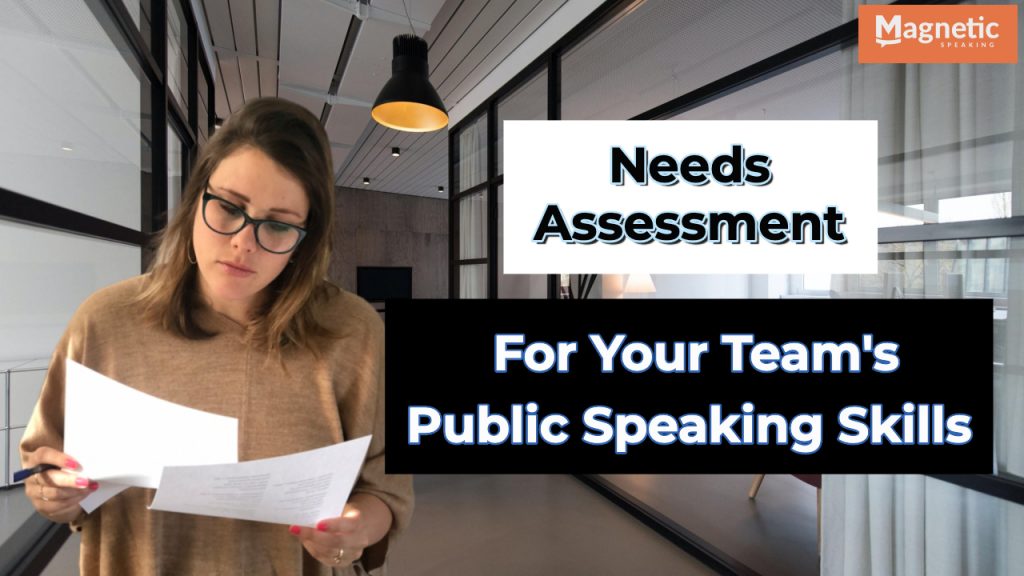You have a team, and you want to improve their communication skills, but you don’t know which training would be the best fit. If you want to get the best public speaking skills training for your team, then you need to conduct a “needs assessment.” A needs assessment highlights specific areas that your team could improve on. Below are different categories to evaluate your team’s public speaking needs. Each category focuses on a specific area of public speaking.
To evaluate your team, run through the list of questions in each category for each of your employees. To help you centralize this, get your own assessment by filling out the form below.
Link to get a copy of the complete assessment.
After you have it filled out for each team member, the assessment will give you a good idea of which public speaking skills training you should focus on.
Messaging
Messaging is all about the specific types of evidence you use to back up your points, the way you structure your major arguments, and the overall flow of your speaking. The goal of messaging is to be clear and influential without rambling.
When evaluating your team members’ messaging, consider these questions:
- Do they have a go-to system to create presentations with a clear, cohesive flow?
- Do they have well-planned and well-thought-out messages?
- Are they concise?
- Do they know how to set the right context depending on their audience?
Delivery
Delivery is how they convey the message, verbally, and physically. On the needs assessment, these are foundational principles that involve eye contact, hand gestures, energy levels, audience engagement, and more.
When evaluating your team members’ delivery, consider these questions:
“While speaking or presenting to a group…”
- Are they comfortable presenting to colleagues and leadership?
- Do they use strong eye contact and expressive body language?
- Do they know how to engage and interact with the room to keep everyone interested?
- Do they have executive presence?

Storytelling:
Storytelling for business is a way to influence, persuade and engage. When telling a story in a casual social setting you don’t always have to be making a point, it can be for fun. However, in a professional context, when telling a story you want to make sure it has a story arc and backs up the point you’re making. Examples are personal stories, company stories and customer success stories.
When evaluating your team members’ storytelling, consider these questions:
“While speaking or presenting to a group, does the team…”
- Use stories?
- If they do use stories, do they…:
- Keep them concise and relevant?
- Have a point?
- Have a few types of different stories to leverage?
Impromptu:
Impromptu speaking is a core component of public speaking because unplanned situations happen! You get called on to share something at a meeting and you didn’t expect it or get challenged by someone in front of the group. Or maybe you get asked a hard question at a Q&A. Impromptu is being able to think quickly on your feet and stay professional.
When evaluating your team members’ impromptu skills, consider these questions:
- Can they think fast on their feet and interact with other smart team members?
- Do they stay grounded and confident when challenged? (Q&A, team meetings)
- Can they show their expertise when they’re not prepared?
- Can they stand up and defend their ideas in a way that’s professional?

Facilitation:
Most meetings require facilitation skills. A team leader should strive to have his/her meetings be effective (get things done), efficient (good use of time), and engaging (where people feel safe to participate and share). Yes, not all team members lead meetings now, yet to be considered for leadership positions they must develop the skill. (This part of the assessment should be done for team leads specifically and potential team leads).
When evaluating your team members’ facilitation skills, consider these questions:
While leading a meeting, is this team member able to…
- Lead a meeting with authority and confidence?
- Keep a meeting moving forward and focused?
- Create action items and a sense of accountability?
- Handle interruptions and interrupt when necessary?

Conclusion
Random and unhelpful training does more damage than good. The team will feel that you are just checking the box for training and that you don’t care about them. However, highly targeted and needed training is great for morale, engagement, and development. The best way to provide targeted public speaking skills training is to do a needs assessment and then shop for training that fills the training needs and gaps it highlights.
P.S. Get a copy of the public speaking training needs assessment below.
Link to get a copy of the complete assessment.
If you need help filling it out or have any additional questions, please request to speak with a training specialist from our Contact Page here.





